|
|
 |
Fiche d'espèce de Copépode |
|
|
Harpacticoida ( Ordre ) |
|
|
|
Ectinosomatidae ( Famille ) |
|
|
|
Microsetella ( Genre ) |
|
|
| |
Microsetella rosea (Dana, 1848) (F,M) | |
| | | | | | | Syn.: | Harpacticus roseus Dana,1848;
Canthocamptus roseus Dana, 1852;
Ectinosoma roseum : Thompson & Scott, 1903 (p.237, 257);
? Macrosetella rosea : Fernandez de Puelles & al., 1996 (p.97, occurrence: p.101, lapsus calami) | | | | Ref.: | | | Giesbrecht, 1892 (p.550, 554, 773, figs.F); Esterly, 1905 (p.211, figs.F); Farran, 1908 b (p.91); A. Scott, 1909 (p.199, Rem.); Pesta, 1913 (p.33); 1920 (p.568); Farran, 1926 (p.299); 1929 (p.211, 297); Monard, 1928 (p.295, figs.F); Campbell, 1929 (p.323, Rem.F); Rose, 1929 (p.53); Wilson, 1932 a (p.177, figs.F); Rose, 1933 a (p.287, figs.F,M); Dakin & Colefax, 1933 (p.208); Mori, 1937 (1964) (p.116, figs.F); Dakin & Colefax, 1940 (p.106, figs.F); Johnson, 1942 b (p.432, figs.M); Klie, 1943 a (n°4, p.3, Rem.F); Lysholm & al., 1945 (p.44); Sewell, 1947 (p.289); Lang, 1948 a (p.232, figs.F,M); Davis, 1949 (p.69, figs.F); Carvalho, 1952 a (p.155, figs.F); Vervoort, 1957 (p.148); Krishnaswamy, 1957 (p.13, Rem.); Marques, 1958 a (p.142); Tanaka, 1960 (p.91, Rem.); Fish, 1962 (p.28); Saraswathy, 1966 (1967) (p.85); Owre & Foyo, 1967 (p.104, figs.F,M); Wells, 1970 (n°133, p.4, figs.F,M); Shih & al., 1971 (p.52, 154); Björnberg, 1972 (p.78, figs., Rem.N, juv. I-V); Razouls, 1972 (p.139); Marques, 1973 (p.252); Chen & al., 1974 (p.68, figs.F); Marques, 1975 (p.47); 1976 (p.999); Marques, 1975 (p.47); Boxshall, 1979 (p.209, figs.F,M); Dawson & Knatz, 1980 (p.10, figs.F); Björnberg & al., 1981 (p.677,figs.F); Gardner & Szabo, 1982 (p.78, figs.F,M); Sazhina, 1985 (p.97, figs.N); Kim & al., 1993 (p.271); Chihara & Murano, 1997 (p.955, Pl.207: F,M); Bradford-Grieve & al., 1999 (p.886, 969, figs.F); Conway & al., 2003 (p.214, figs.F,M, Rem.); Avancini & al., 2006 (p.129, Pl. 97, figs.F,M, Rem.); Vives & Shmeleva, 2010 (p.104, figs.F,M, Rem.) |  issued from : Q.-c Chen & S.-z. Zhang & C.-s. Zhu in Studia Marina Sinica, 1974, 9. [Pl.24, Figs.1-2]. Female (from China Seas): 1, habitus (lateral left side); 2, P5.
|
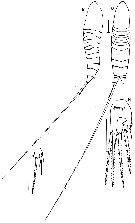 issued from : G.A. Boxshall in Bull. Br. Mus. nat. Hist. (Zool.), 1979, 35 (3). [p.208, Fig.2, K-N). Female: M, habitus (dorsal); N, P5. Male: K, habitus (lateral); L, P5.
|
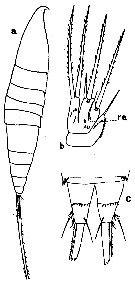 issued from : C.O. Esterly in Univ. Calif. Publs Zool., 1905, 2 (4). [p.211, Fig.52]. Female (from San Diego Region: near La Jolla): a, habitus (lateral); b, P5 (re = exopod); c, caudal rami (ventral).
|
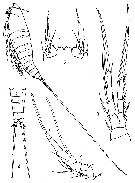 issued from : M.W. Johnson in Trans. Am. microsc. Soc., 1942, 61. [p.431, Pl.I]. Male (from San Diego and San Francisco): 1, habitus (lateral); 2, P5; 3, P1; 4, posterior part of body (dorsal); 5, A1.
|
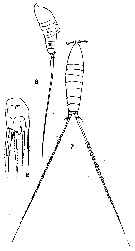 issued from : T. Mori in The Pelagic copepoda from the neighbouring waters of Japan, 1937 (1964). [Pl. 64, Figs.6-8]. Female: 6-7, habitus (lateral and dorsal, respectively); 8, P5.
|
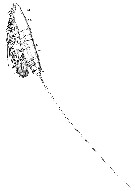 Issued from : W. Giesbrecht in Systematik und Faunistik der Pelagischen Copepoden des Golfes von Neapel und der angrenzenden Meeres-Abschnitte. – Fauna Flora Golf. Neapel, 1892, 19 , Atlas von 54 Tafeln. [Taf.44, Fig.41. Female: 41, habitus (lateral).
|
 Issued from : W. Giesbrecht in Systematik und Faunistik der Pelagischen Copepoden des Golfes von Neapel und der angrenzenden Meeres-Abschnitte. – Fauna Flora Golf. Neapel, 1892, 19 , Atlas von 54 Tafeln. [Taf.44, Fig.32]; Female: 32, habitus (dorsal).
|
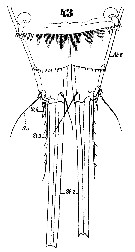 Issued from : W. Giesbrecht in Systematik und Faunistik der Pelagischen Copepoden des Golfes von Neapel und der angrenzenden Meeres-Abschnitte. – Fauna Flora Golf. Neapel, 1892, 19 , Atlas von 54 Tafeln. [Taf.44, Fig.43]. Female: 43, anal segment and caudal rami (ventral).
|
 Issued from : W. Giesbrecht in Systematik und Faunistik der Pelagischen Copepoden des Golfes von Neapel und der angrenzenden Meeres-Abschnitte. – Fauna Flora Golf. Neapel, 1892, 19 , Atlas von 54 Tafeln. [Taf.44, Figs.35, 37, 38]. Female: 35, Mx2; 37, Md; 38, Mxp.
|
 Issued from : W. Giesbrecht in Systematik und Faunistik der Pelagischen Copepoden des Golfes von Neapel und der angrenzenden Meeres-Abschnitte. – Fauna Flora Golf. Neapel, 1892, 19 , Atlas von 54 Tafeln. [taf.44, Fig.49]. Female: 49, A1. Ae = aesthetasc.
|
 Issued from : W. Giesbrecht in Systematik und Faunistik der Pelagischen Copepoden des Golfes von Neapel und der angrenzenden Meeres-Abschnitte. – Fauna Flora Golf. Neapel, 1892, 19 , Atlas von 54 Tafeln. [Taf.44, Fig.48]. Female: 48, P1. Si = inner seta; Se = outer seta; Re 3= 3rd outer segment.
|
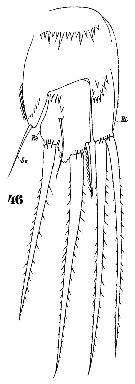 Issued from : W. Giesbrecht in Systematik und Faunistik der Pelagischen Copepoden des Golfes von Neapel und der angrenzenden Meeres-Abschnitte. – Fauna Flora Golf. Neapel, 1892, 19 , Atlas von 54 Tafeln. [Taf.44, Fig.46]; Female: 46, P5. Ri = inner segment; Re = outer segment; Se = outer seta.
| | | | | Ref. compl.: | | | Rose, 1925 (p.152); Wilson, 1942 a (p.194); Massuti Alzamora, 1942 (p.108, Rem.); Sewell, 1948 (p.394, 490, 493, 506); C.B. Wilson, 1950 (p.266); Fleury, 1950 (p.47, fig.2); King & Hida, 1955 (p.11); Yamazi, 1958 (p.154, Rem.); Fagetti, 1962 (p.40); Ganapati & Shanthakumari, 1962 (p.11, 16); Gaudy, 1962 (p.93, 99, Rem.: p.117) ; Giron-Reguer, 1963 (p.56); V.N. Greze, 1963 a (tabl.2); Björnberg, 1963 (p.68, Rem.); Unterüberbacher, 1964 (p.33); De Decker, 1964 (p.16, 23, 29); De Decker & Mombeck, 1964 (p.13); Shmeleva, 1965 b (p.1350, lengths-volume -weight relation); Martin, 1965 (p.188); Neto & Paiva, 1966 (p.35, Table III); Mazza, 1966 (p.73); Chakroun, 1966 (p.67, Tableau); Pavlova, 1966 (p.45); Ehrhardt, 1967 (p.742, geographic distribution, Rem.); Séguin, 1968 (p.488); Delalo, 1968 (p.138); Vinogradov, 1968 (1970) (p.78, 256); Dowidar & El-Maghraby, 1970 (p.269); Deevey, 1971 (p.224); Della Croce & al., 1972 (p.1, Rem.); Apostolopoulou, 1972 (p.329, 374); Björnberg, 1973 (p.370, 388); Desgouille, 1973 (p.1, 131, Rem.: p.138); de Bovée, 1974 (p.109, 124); Corral Estrada & Pereiro Muñoz, 1974 (tab.I); Vives & al., 1975 (p.54, tab.II, III, IV); Deevey & Brooks, 1977 (p.256, tab.2, Station "S"); Judkins, 1980 (p.475, Rem.: p. 477); Vaissière & Séguin, 1980 (p.23, tab.2); Gallo, 1981 (p.847, Rem.: p.849); Vives, 1982 (p.295); Kovalev & Shmeleva, 1982 (p.85); Bityukov & al., 1984 (tab.1); Pieper & Holliday, 1984 (p.226, Fig.3); De Decker, 1984 (p.317, 356: chart); Guangshan & Honglin, 1984 (p.118, tab.); Tremblay & Anderson, 1984 (p.8); Scotto di Carlo & al., 1984 (p.1043); Brinton & al., 1986 (p.228, Table 1); Sarkar & al., 1986 (p.178); Diouf & Diallo, 1987 (p.260); Lozano Soldevilla & al., 1988 (p.61); Othman & al., 1990 (p.561, 564, Table 1); Hirakawa & al., 1990 (tab.3); Dai & al., 1991 (tab.1); Yoo, 1991 (tab.1); Seguin & al., 1993 (p.23); Godhantaraman, 1994 (tab.5, 6); Lopes, 1994 (tab.1); Webber & Roff, 1995 (tab.1); Böttger-Schnack, 1995 (p.93); Shih & Young, 1995 (p.75); Kotani & al., 1996 (tab.2); Go & al., 1997 (tab.1); Sharaf & Al-Ghais, 1997 (tab.1); Park & Choi, 1997 (Appendix); Noda & al., 1998 (p.55, Table 3, occurrence); Hure & Krsinic, 1998 (p.103); Gilabert & Moreno, 1998 (tab.1, 2); Suarez-Morales & Gasca, 1998 a (p.113); Siokou-Frangou, 1999 (p.478); El-Serehy, 1999 (p.172, Table 1, occurrence); Neumann-Leitao & al., 1999 (p.153, tab.2); Dolganova & al., 1999 (p.13, tab.1); Bragina, 1999 (p.196); Razouls & al., 2000 (p.343, Appendix); Ueda & al., 2000 (tab.1); Fernandez-Alamo & al., 2000 (p.1139, Appendix); El-Sherif & Aboul Ezz, 2000 (p.61, Table 3: occurrence); Seridji & Hafferssas, 2000 (tab.1); Plounevez & Champalbert, 2000 (p.175, Table III, IV, V, abundance vs fish, Rem.: p.185); Kosobokova & Hirche, 2000 (p.2029, tab.2); Moraitou-Apostolopoulou & al., 2000 (tab.I); Sautour & al., 2000 (p.531, Table II, abundance); d'Elbée, 2001 (tabl.1); Zerouali & Melhaoui, 2002 (p.91, Tableau I); Bode & al., 2003 (p.85, Table 1, abundance); Vukanic, 2003 (p.139, tab.1); Rezai & al., 2004 (p.490, tab.2); Daly Yahia & al., 2004 (p.366, fig.4, tab.1); Gallienne al., 2004 (p.5, tab.3); Baker & al., 2005 (tabl.); Zuo & al., 2006 (p.164: tab.1); Isari & al., 2006 (p.241, tab.II); Sterza & Fernades, 2006 (p.95, Table 1, occurrence); Dias & Araujo, 2006 (p.76, Rem., chart); Papastephanou & al., 2006 (p.3078, Table 3); David & al., 2007 (p.59: tab.2); Valdés & al., 2007 (p.104: tab.1); Khelifi-Touhami & al., 2007 (p.327, Table 1); Cabal & al., 2008 (289, Table 1); Humphrey, 2008 (p.85: Appendix A); Ayon & al., 2008 (p.238, Table 4: Peruvian samples); Neumann-Leitao & al., 2008 (p.799: Tab.II, fig.6); Morales-Ramirez & Suarez-Morales, 2008 (p.515, 523); Raybaud & al., 2008 (p.1765, Table A1); Rossi, 2008 (p.90: Tableau XII); Ohtsuka & al., 2008 (p.115, Table 5); Galbraith, 2009 (pers. comm.); Miyashita & al., 2009 (p.815, Tabl.II); Tseng & al., 2009 (p.327, fig.5, feeding); Hafferssas & Seridji, 2010 (p.353, Table 2); Drira & al., 2010 (p.145, Tanl.2); Hernandez-Trujillo & al., 2010 (p.913, Table 2); Hidalgo & al., 2010 (p.2089, Table 2); Dias & al., 2010 (p.230, Table 1); Mazzocchi & Di Capua, 2010 (p.430); Medellin-Mora & Navas S., 2010 (p.265, Tab. 2); Fazeli & al., 2010 (p.153, Table 1); Maiphae & Sa-ardrit, 2011 (p.641, Table 2, 3, Rem.); Kramer & al., 2011 (p.1062, Table 2, occurrence vs meiofauna); Zhang G.-T. & Wong, 2011 (p.277, fig.6, 7, abundance, indicator); Isari & al., 2011 (p.51, Table 2, abundance vs distribution); Selifonova, 2011 a (p.77, Table 1, alien species in Black Sea); Costa R.G. da & al., 2011 (p.364, Table 1, seasonal occurrence); Andersen N.G. & al., 2011 (p.71, Fig.3: abundance); Tutasi & al., 2011 (p.791, Table 2, abundance distribution vs La Niña event); Delpy & al., 2012 (p.1921, Table 2); Uysal & Shmeleva, 2012 (p.909, Table I); Dorgham & al., 2012 (p.473, Table 3: abundance %); Jean & al., 2012 (p.12, Table 3, protein vs environmental metal stress); Lavaniegos & al., 2012 (p. 11, Appendix); Salah S. & al., 2012 (p.155, Tableau 1); Nikolioudakis & al., 2012 (p.173, Table 2: Ivelv's selectivity index); Johan & al., 2012 (2013) (p.1, Table 1); Krsinic & Grbec, 2012 (p.57, 64: abundance); Rekik & al., 2012 (p.336, Table 1, abundabce); Gubanova & al., 2013 (in press, p.4, Table 2); in CalCOFI regional list (MDO, Nov. 2013; M. Ohman, comm. pers.); Tachibana & al., 2013 (p.545, Table 1, seasonal change 2006-2008); Melo Jùnior & al., 2013 (p.363, Table 2, egg production); Jagadeesan & al., 2013 (p.27, Table 3, seasonal variation); Garbosa da Costa & al., 2013 (p.756, Table 1, abundance vs tide); Lidvanov & al., 2013 (p.290, Table 2, % composition); Bonecker & a., 2014 (p.445, Table II: frequency, horizontal & vertical distributions); Pansera & al., 2014 (p.221, Table 2, abundance); Zaafa & al., 2014 (p.67, Table I, occurrence); Fierro Gonzalvez, 2014 (p.1, Tab. 3, 5, occurrence, abundance); Dias & al., 2015 (p.483, Table 2, abundance, biomass, production); Rojas-Herrera & al., 2016 (p.40, Table 2: temporal abundance); Zakaria & al., 2016 (p.1, Table 1) ; Benedetti & al., 2016 (p.159, Table I, fig.1, functional characters); Ben Ltaief & al., 2017 (p.1, Table III, Summer relative abundance); El Arraj & al., 2017 (p.272, table 2, spatial distribution); Atique & al., 2017 (p.1, Table 1); Abo-Taleb & Gharib, 2018 (p.139, Table 5, occurrence %); Benedetti & al., 2018 (p.1, Fig.2: ecological functional group); Palomares-Garcia & al., 2018 (p.178, Table 1: occurrence)
| | | | NZ: | 22 | | |
|
Carte de distribution de Microsetella rosea par zones géographiques
|
| | | | | | | | | | | | | | | | | |  issued from : A.A. Shmeleva in Bull. Inst. Oceanogr., Monaco, 1965, 65 (n°1351). [Table 6: 40]. Microsetella rosea (from South Adriatic). issued from : A.A. Shmeleva in Bull. Inst. Oceanogr., Monaco, 1965, 65 (n°1351). [Table 6: 40]. Microsetella rosea (from South Adriatic).
Dimensions, volume and Weight wet. Means for 50-60 specimens. Volume and weight calculated by geometrical method. Assumed that the specific gravity of the Copepod body is equal to 1, then the volume will correspond to the weight. |
| | | | Loc: | | | Antarct. (Indian: 67°S, 40°E, exceptional), sub-Antarct. (Indian), South Africa (off Cape of Good Hope, E & S), Namibia, Angola, Baia Farta, G. of Guinea, Casamance, Dakar, Cape Verde Is., Morocco-Mauritania, Canary Is., Cap Ghir (Morocco), off Madeira, Portugal, off Coruña, Brazil (S, Ubatuba, off Rio de Janeiro, Campos Basin, Vitoria Bay, off Vitoria, off Macaé, Guarau estuary, off Natal, Ajurureua beach, Caeté Estuary, Amazon estuary), Venezuela, Caribbean Colombia, Barbados Is., Caribbean, Jamaica, Cuba, E Costa Rica, G. of Mexico, Florida, Sargasso Sea, off Bermuda (Station "S"), Narragansett Bay, Woods Hole, off E Newfoundland, W Ireland, North Sea, Bay of Biscay, La Pallice roadstead (rare), English Channel, Ibero-moroccan Bay, off W Tangier, Medit. (M'Diq, Alboran Sea, Algiers, Gulf of Annaba, El Kala shelf, Castellon, Banyuls, Thau Lagoon, Berre Lagoon, Marseille, Toulon Harbour, Genova, Ligurian Sea, Tyrrhenian Sea, Lake Faro (Sicily), Strait of Messina, NW Tunisia, Adriatic Sea, G. of Gabès, Sfax, Tripoli, Ionian Sea, Aegean Sea, Thracian Sea, Black Sea, Lebanon Basin, W Egyptian coast, Alexandria), G. of Suez, off Sharm El-Sheikh, , Hurghada, Safaga, Red Sea, Gulf of Oman, G. of Aden, Arabian Sea, Arabian Gulf, UAE coast, Laccadive Is., Maldive Is., Mozambique Channel, Madagascar, Rodrigues Is. - Seychelles, Mascarene Basin, Sri Lanka, India (S, Madras, Gulf of Mannar, Palk Bay, Lawson's Bay, Hooghly estuary), Straits of Malacca, G. of Thailand, Indonesia-Malaysia, Sarawak: Bintulu coast, Philippines, Viet-Nam, Hong Kong, China Seas (Yellow Sea, East China Sea, South China Sea, Xiamen Harbour), Okinawa, S Korea, Japan Sea, Japan, Kuchinoerabu Is., Tokyo Bay, Tanabe Bay, Bering Sea, Aleutian Is., Queen Charlotte Is., British Columbia (rare), Pacif. (SW equatorial), Australia (G. of Carpentaria, New South Wales); New Zealand, off S Tasmania, Hawaii, off S Hawaii, Vancouver Is., California (San Pedro Bay, Bodega Bay), Baja California (Bahia Magdalena, La Paz), Gulf of California, Bahia de los Angeles, W Mexico, Acapulco Bay, G. of Tehuantepec, W Costa Rica, Galapagos-Ecuador, Peru, Chile (N-S) | | | | N: | 263 | | | | Lg.: | | | (35) [Atlant.] F: 0,57; [N-Z] F: 0,9-0,84; (38) F: 0,83; (45) F: 0,85-0,65; (46) F: 0,68-0,64; (59) F: 0,9-0,57; (66) F: 0,59-0,36; M: 0,51-0,37; (91) F: 0,85-0,64; (104) F: 0,67; (109) F: 1,3-0,62; (138) F: 0,85-0,64; M: 0,7-0,6; (141) F: 0,9-0,64; (142) F: 0,9-0,84; (237) F: 0,60-0,65; (333) F: 0,65; (336) F: 0,75-0,55; (432) F: 1,02-0,55; (449) F: 0,85-0,64; (530) F: 0,9; (618) F: 0,84; (651) F: 0,75-0,61; (707) M: 0,6-0,7; (719) F: 0,7-0,6; (786) F: 0,93-0,79; (991) F: 0,64-0,85; {F: 0,36-1,30; M: 0,37-0,70} | | | | Rem.: | épipélagique.
Sampling depth (sub-Antarct.) : 0-250-500 m.
Voir aussi les remarques en anglais | | | Dernière mise à jour : 25/10/2022 | |
|
|
 Toute utilisation de ce site pour une publication sera mentionnée avec la référence suivante : Toute utilisation de ce site pour une publication sera mentionnée avec la référence suivante :
Razouls C., Desreumaux N., Kouwenberg J. et de Bovée F., 2005-2025. - Biodiversité des Copépodes planctoniques marins (morphologie, répartition géographique et données biologiques). Sorbonne Université, CNRS. Disponible sur http://copepodes.obs-banyuls.fr [Accédé le 29 décembre 2025] © copyright 2005-2025 Sorbonne Université, CNRS
|
|
 |
 |
















